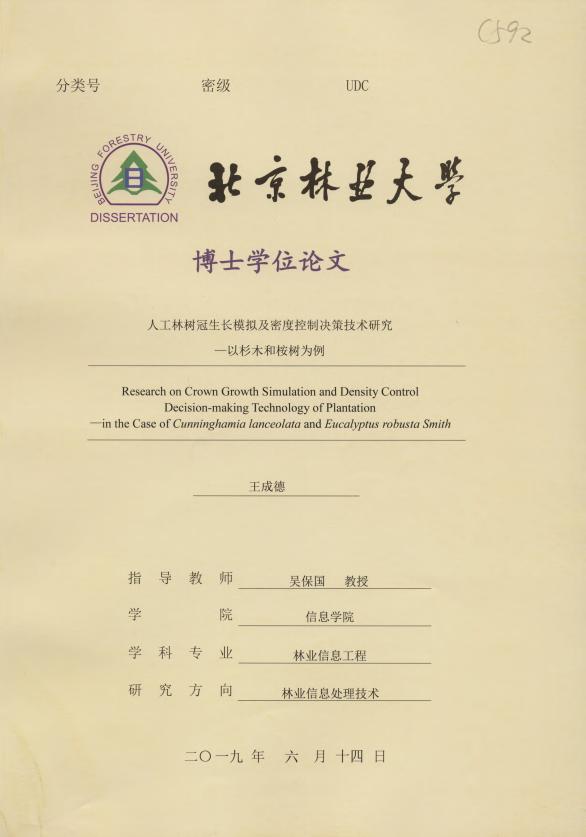| 英文摘要 |
Plantation plays an important role in providing timber products and protecting the ecological environment. How to improve the quality of forests accurately and manage plantations scientifically is an important way to achieve sustainable forest management. As an important part of plantation, crown size (crown width, crown length, outline shape and crown volume) can not only directly reflect the growth vigor and spatial attributes of trees, but also be used to evaluate whether forests need to be managed and to determine thinning parameters. Crown growth and crown overlap among individual trees can provide theoretical basis for density control and adjustment. Using the crown model to drive the 3D visualization of stand, the individual occupancy space under different stand conditions can be visually displayed. Combined with the stand density control decision model, the status of the stand can be qualitatively and quantitatively analyzed to provide decision support services for forest management. This study focused on plantation management, taking the Chinese fir of Fujian and the eucalyptus of Guangxi as the objects, based on the data collection of temporary and permanent plots and the modeling data were clustered by analysis of variance and multiple comparison methods. Three major types of models, including simple single equation model, segmentation model and variable index were collected and organized and the models were fitted using the clustering data and compared to select the optimal crown profile model under different groupings. In order to further research the relationship between forest factor (breast diameter, tree height and stand density) and crown morphology, the crown profile models in different groups including the Chinese fir Group 1 (5-10 years), Group II (11-15 years) and Group III (≥16 years) and the eucalyptus Group I (1-2 years), Group II (3-4 years) and Group III (5-6 years). We developed the crown width and crown length dynamic growth model, by combining with the outer crown profile model to predict the dynamic growth indirectly. The crown width growth model was constructed by using the modified function method which the power function was used as the crown-age potential growth equation and the exponential equation of the DBH was used as the error correction function. To describe the dynamic change of crown length, the relationships between crown length and other factors including age, site and density were comprehensively analysed, correlation analysis and stepwise regression were set. Finally the crown length model with tree height and age as independent variables was constructed. To further estimate the crown volume and biomass, the crown profile-volume compatibility model equations and crown factor empirical model were used. The crown profile-volume compatibility model equations ensured the consistency and unbiasedness of the model parameters. But the complex crown profile model equations such as the variable index was not feasible, the crown model constructed by using crown factors such as crown width and crown length was effective. Because the measurement data of the crown profile from the same tree had autocorrelation and heteroscedasticity problems. The marginal model and the nonlinear mixed effect were used to develop the crown profile models. The researches showed that the accuracy of the fitted prediction results of the modeling samples and the verification samples were better than the least squares method. The marginal model method developed the weighted variance function and the first-order continuous autoregression in the form of power function. The result showed CAR(1) variance-covariance structure effectively solved the heteroscedasticity and autocorrelation problem. The nonlinear mixed effect method solved the problem by adding random effect parameters, determining the variance-covariance structure within the group, and the random effect variance-covariance matrix. In actual forest management, in order to visually reflect the growth vigor of the crown under different growth conditions and the degree of crown overlap among the individual trees, based on the constructed crown profile model, this paper studied the tree characteristics, crown and branch structures, and constructed a 3D digital XML model that can expressed the shape of trees in forests. The model considered the external factors affecting the growth of forest trees, and was more in line with the actual situation of artificial forest trees. It was especially suitable for describing the tree crown shape and analyzing the spatial distribution pattern of forest trees in the process of forest visualization. In order to qualitatively and quantitatively describe the growth status of stand tree under different tending and thinning measures, a multi-target stand density control decision models with six functional modules such as traditional stand density control model, scale distribution models, tree taper equations, crown shape models, and annual net present value of stand were established. This functional module can not only describe the average accumulated harvest, economic benefit, biomass and carbon storage of the stand, but also individual trees growth in forests. Based on problems existing in the current management decision-making system, we constructed an Assistant Decision-making System for Plantation including the demand analysis, system flow and function design and the key technologies of system. The simulation system can provide decision support services for forest management. Keywords: crown profile model, crown dynamic growth model, digital 3D model, stand density control decision model
|

